|
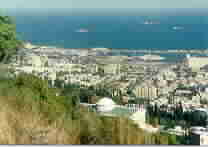 So, here I am! Being 'a bear of little brain', I decided to walk down from the hotel, and immediately got lost. However, that meant that I ended up walking along Panorama Road from whence I had my first glimpse of the Shrine of the Báb and the Seat of the Universal House of Justice, and past the top of the terraces amidst the dust of the construction work. At first I did not realize what this work was, and it was only when I came across a large hoarding that I realised where I was. The view down the mountain was spectacular, to say the least, and gave one just an insight into how incredibly ambitious these works are.
So, here I am! Being 'a bear of little brain', I decided to walk down from the hotel, and immediately got lost. However, that meant that I ended up walking along Panorama Road from whence I had my first glimpse of the Shrine of the Báb and the Seat of the Universal House of Justice, and past the top of the terraces amidst the dust of the construction work. At first I did not realize what this work was, and it was only when I came across a large hoarding that I realised where I was. The view down the mountain was spectacular, to say the least, and gave one just an insight into how incredibly ambitious these works are.
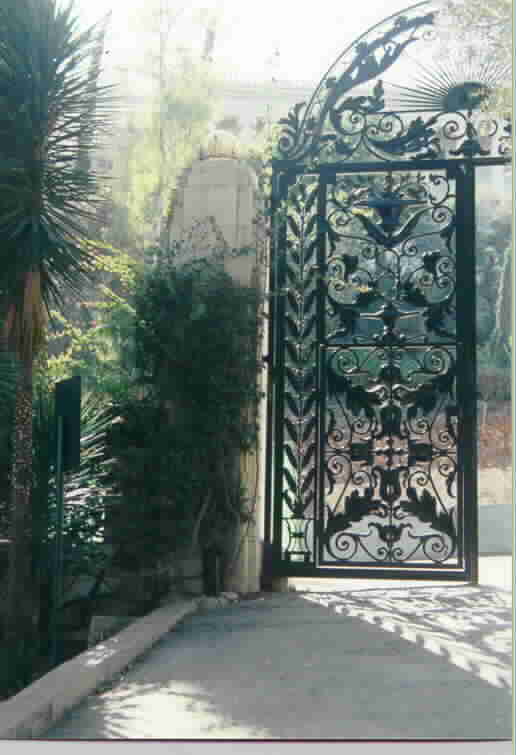 After yet more walking (all of it downhill but seemingly interminable), there I was by the extensive earthworks below the Archives Building, where the road is being lowered by some six metres to allow the terraces to pass over it. And then, at last, I arrive at the gate into the Shrine Gardens, almost missing it in all the noise and bustle. It may be November, but it is hot, though with a strong wind blowing off the sea – very unseasonable, I am told, and worrying as water is getting short. Entering the gardens I am quite suddenly away from it all (or at least, so it seems) and enter into the peaceful atmosphere of the Pilgrim House and go and register, and then to just sit and recover from that walk, watching the people come and go.
After yet more walking (all of it downhill but seemingly interminable), there I was by the extensive earthworks below the Archives Building, where the road is being lowered by some six metres to allow the terraces to pass over it. And then, at last, I arrive at the gate into the Shrine Gardens, almost missing it in all the noise and bustle. It may be November, but it is hot, though with a strong wind blowing off the sea – very unseasonable, I am told, and worrying as water is getting short. Entering the gardens I am quite suddenly away from it all (or at least, so it seems) and enter into the peaceful atmosphere of the Pilgrim House and go and register, and then to just sit and recover from that walk, watching the people come and go.
In the afternoon we were split up into our four groups of 25 and had a talk on what would be happening during our time at the World Centre. My group was made up of people from Unalaska, Canada, Chile, Italy, Norway and, of course, Skye.
 At half past three, after a short talk from a member of the ITC, we proceed slowly through those beautiful gardens to the Shrine of the Báb. I have to admit that I had dreaded this moment, expecting to end up in tears, but actually managing to stay dry-eyed – probably because of the large numbers of people present. The first visit (it can never happen again) was brief: just time for the chanting of the Tablet of Visitation and a brief meditation. Each person reacts differently – some prostrating themselves, others kneeling, or sitting, and yet others standing. All too soon we are backing out of the door (and falling down the step – unnoticed on entry) and passing to the Shrine of 'Abdu'l-Bahá. Once more there is just time for the reading of the Prayer of Visitation before we make our way back to the Pilgrim House. As I write I am sitting opposite a life-size portrait of 'Abdu'l-Bahá. It is as if He is looking at me – and into me. Very disconcerting.
At half past three, after a short talk from a member of the ITC, we proceed slowly through those beautiful gardens to the Shrine of the Báb. I have to admit that I had dreaded this moment, expecting to end up in tears, but actually managing to stay dry-eyed – probably because of the large numbers of people present. The first visit (it can never happen again) was brief: just time for the chanting of the Tablet of Visitation and a brief meditation. Each person reacts differently – some prostrating themselves, others kneeling, or sitting, and yet others standing. All too soon we are backing out of the door (and falling down the step – unnoticed on entry) and passing to the Shrine of 'Abdu'l-Bahá. Once more there is just time for the reading of the Prayer of Visitation before we make our way back to the Pilgrim House. As I write I am sitting opposite a life-size portrait of 'Abdu'l-Bahá. It is as if He is looking at me – and into me. Very disconcerting.
Well, that's it. Day 1 ended – or, so I thought. I don't know really what I expected – certainly not what I saw, or felt. The shrines, so beautiful and complex in their external appearance, yet so simple and unadorned inside. It is just how it should be – nothing to distract the eye, to turn it into a museum – to be visited and ticked off in the list of "things we did on holiday."
 Well! Having said all that, I was just packing up when everyone stood up as Hand of the Cause, Mr Furútan joined us! Mainly he talked about the Pilgrim House – except that it had been a lot of other things: this room Abu'l Fadl lived in, this one John Esslemont, etc. Here 'Abdu'l-Bahá and there Shoghi Effendi, etc. So I have walked where the Master walked – for the second time; but this time I knew about it. (This is a allusion to the fact that I used to live in Clifton only a short distance from where 'Abdu'l-Bahá had stayed when He visited Bristol.) And then Dr Varqá joined Mr Furútan and spoke about the Four Year Plan. How it was a Plan for nations, communities, families and individuals – and how the world is ready to receive the message of Bahá'u'lláh. We ended the evening with prayers in Chinese, Italian, Hindi, Turkish, Swedish, English and Persian.
Well! Having said all that, I was just packing up when everyone stood up as Hand of the Cause, Mr Furútan joined us! Mainly he talked about the Pilgrim House – except that it had been a lot of other things: this room Abu'l Fadl lived in, this one John Esslemont, etc. Here 'Abdu'l-Bahá and there Shoghi Effendi, etc. So I have walked where the Master walked – for the second time; but this time I knew about it. (This is a allusion to the fact that I used to live in Clifton only a short distance from where 'Abdu'l-Bahá had stayed when He visited Bristol.) And then Dr Varqá joined Mr Furútan and spoke about the Four Year Plan. How it was a Plan for nations, communities, families and individuals – and how the world is ready to receive the message of Bahá'u'lláh. We ended the evening with prayers in Chinese, Italian, Hindi, Turkish, Swedish, English and Persian.
| Day 2 |
Visits to the Shrine of Bahá'u'lláh and
Meeting with the members of the Universal House of Justice |
|
So, today is THE day. No words can really describe it but I hope I can convey just a hint of what I experienced.
At 9.00 we set off down Hatzionut to the waiting buses for our first visit to Bahjí. This quite a long journey, passing through both residential and industrial areas of Haifa, both affluent and derelict. Gradually we leave behind the urban sprawl and are in "the country". I had expected the landscape to be semi-desert but in fact there is still a fair amount of greenery about, with orange groves and fertile fields—but it is all very dusty. On this initial trip we approached Bahjí from the north, so as to avoid the less attractive route through the suburbs of ‘Akká so there is no warning that we are approaching Bahjí. On our arrival, we drive through a beautiful pair of wrought iron gates, hardly any wider the bus, and then up the narrow driveway to the car park where we alight into the dusty heat.
 There
is an air of anticipation. Some, of course, have been here before but for
us that haven't it is yet another of those moments when we just do not
know what to expect. We are less than 500m from the most holy spot on the
face of the earth. But we do not approach the Shrine directly. Rather,
we turn left and pass along the perimeter path or the Haram-i-Aqdas, past
two pine trees which used to shade the Holy Family during their picnics
in the grounds around Bahjí. Currently only a quarter of a circle
(it is late autumn), I have to imagine the Haram-i-Aqdas totally encircling
the Shrine of Bahá'u'lláh and that pilgrims will use its
outer path to circumambulate the physical remains of the Blessed Beauty. There
is an air of anticipation. Some, of course, have been here before but for
us that haven't it is yet another of those moments when we just do not
know what to expect. We are less than 500m from the most holy spot on the
face of the earth. But we do not approach the Shrine directly. Rather,
we turn left and pass along the perimeter path or the Haram-i-Aqdas, past
two pine trees which used to shade the Holy Family during their picnics
in the grounds around Bahjí. Currently only a quarter of a circle
(it is late autumn), I have to imagine the Haram-i-Aqdas totally encircling
the Shrine of Bahá'u'lláh and that pilgrims will use its
outer path to circumambulate the physical remains of the Blessed Beauty.
 After a short talk from our guide, we pass though the Amelia Collins Gate – what an honour to have a gate named after you at Bahjí – and, gradually getting quieter as we approach our destination, proceed up the path to the small porch in front of the Shrine of the Blessed Beauty.
After a short talk from our guide, we pass though the Amelia Collins Gate – what an honour to have a gate named after you at Bahjí – and, gradually getting quieter as we approach our destination, proceed up the path to the small porch in front of the Shrine of the Blessed Beauty.
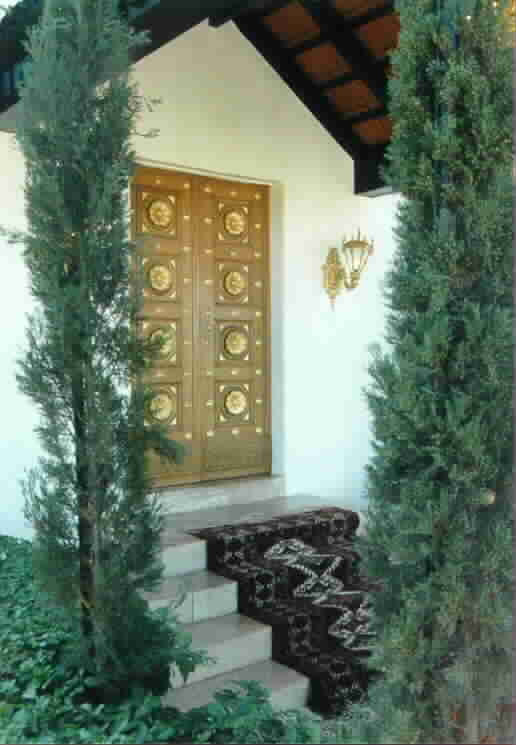
Here we remove our shoes, and leave our bags and cameras and, one by
one, enter the Shrine. The central room of the Shrine is barely able to
hold the fifty pilgrims present. It is simply laid out with a small "garden"
in the centre and with layers of carpets laid round the walls for us to
walk, kneel or prostrate ourselves on. There in the right hand corner is
the threshold of the small room in which the Blessed Beauty lies. No fanfare,
no fireworks, no hype — just a simple side room in a small house, permeated
with the most wonderful fragrance of roses. As before, in the Shrine of
the Báb, the Tablet of Visitation is read and then, one by one,
we proceed to pass round the room, surrounded by that wonderful perfume
and bow before the threshold. Once again, we are left to our own thoughts,
to remain to pray and meditate, or to leave the Shrine and walk in the
gardens around it.
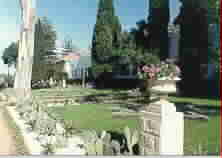 The gardens surrounding Bahjí are beautiful and extensive though, at
this time of year, not complete (i.e. all four quadrants are there but
not planted). Work was going on rapidly to plant the complete gardens ready
for the spring. However, all too soon it was time to get back onto the
bus and head to Haifa. As we approach the city, we can see the golden roof
of the Shrine of the Báb standing out amongst the yellowish-grey
of the buildings (yet it is not an unattractive city).
The gardens surrounding Bahjí are beautiful and extensive though, at
this time of year, not complete (i.e. all four quadrants are there but
not planted). Work was going on rapidly to plant the complete gardens ready
for the spring. However, all too soon it was time to get back onto the
bus and head to Haifa. As we approach the city, we can see the golden roof
of the Shrine of the Báb standing out amongst the yellowish-grey
of the buildings (yet it is not an unattractive city).
Several of the pilgrims leave the bus in the Hadar district and lunch
on falafels (Israel's national dish) before climbing back up the "hill"
to the Pilgrim House.
In the afternoon, we are taken up to the Seat of the Universal House
of Justice to be greeted by the members of the House. What gentle men,
and yet they exude such a power. For the first time, I see one of my fellow
pilgrims in tears, overcome by the realization that this group of nine,
when meeting, are the channel for God's work on earth here and now. Not
something remote, in the past or inaccessible, but present, and talking
with us just like any of our friends would. They are IT!
After the formal introduction, our chairs were moved away and the members
of the House came down and greeted and spoke to us personally. It is so
quiet and yet so powerful, this place, though in a totally different way
from the shrines. There is absolutely no way I can express it. |
| Day 3 |
Dawn Prayers (6:30)
First visit to the house of 'Abdu'l-Bahá and
Meeting with the members of the International Teaching Centre
|
|
Before you ask, no, I did not make it to Dawn Prayers.

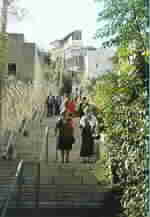 Well, it is not just the Bahá'ís that are carving up the mountain!
There are new roads and houses everywhere. Anyway, I finally manage to
get to the Pilgrim House and to join my fellow pilgrims, Roderick and Brynhild,
while we wait for the day's activities to start. Then it's down the Shifra
Stairs (more steps – about 150 of them) and a short walk to the house of
'Abdu'l-Bahá, a small attractive house with steps leading up to
the front door and surrounded by a beautiful garden. (Actually, small is
somewhat comparative. You would be able to fit my croft cottage into the
central room, probably twice over).
Well, it is not just the Bahá'ís that are carving up the mountain!
There are new roads and houses everywhere. Anyway, I finally manage to
get to the Pilgrim House and to join my fellow pilgrims, Roderick and Brynhild,
while we wait for the day's activities to start. Then it's down the Shifra
Stairs (more steps – about 150 of them) and a short walk to the house of
'Abdu'l-Bahá, a small attractive house with steps leading up to
the front door and surrounded by a beautiful garden. (Actually, small is
somewhat comparative. You would be able to fit my croft cottage into the
central room, probably twice over).
 Inside it is cool and peaceful. We are to meet with 'Amatu'l-Bahá Rúhíyyih Khánum, Hand of the Cause of God and wife of the beloved Guardian. At 86 years old, she is still an indomitable lady. She speaks to us of the privilege of the Pilgrimage we are on and how, in years to come, there will be no visits to the insides of the Shrines. How tens of thousands of Bahá'ís will converge on Haifa every day.
Inside it is cool and peaceful. We are to meet with 'Amatu'l-Bahá Rúhíyyih Khánum, Hand of the Cause of God and wife of the beloved Guardian. At 86 years old, she is still an indomitable lady. She speaks to us of the privilege of the Pilgrimage we are on and how, in years to come, there will be no visits to the insides of the Shrines. How tens of thousands of Bahá'ís will converge on Haifa every day. 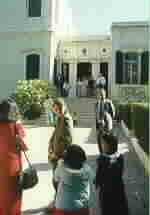 She speaks of teaching. How all we need to know to teach is that a new teaching has come, that it is good and comes from God, and that it was brought to us by Bahá'u'lláh. She speaks of her mother, May Maxwell, who was the first western martyr and who, praying for a son, was told by 'Abdu'l-Bahá that she would have a famous son. And she did – the son being her son-in-law, Shoghi Effendi. After her talk, she answered questions from the pilgrims and then, quite suddenly, it is over and we collect our
belongings and are back out into the town and eat Shwarmi. She speaks of teaching. How all we need to know to teach is that a new teaching has come, that it is good and comes from God, and that it was brought to us by Bahá'u'lláh. She speaks of her mother, May Maxwell, who was the first western martyr and who, praying for a son, was told by 'Abdu'l-Bahá that she would have a famous son. And she did – the son being her son-in-law, Shoghi Effendi. After her talk, she answered questions from the pilgrims and then, quite suddenly, it is over and we collect our
belongings and are back out into the town and eat Shwarmi.
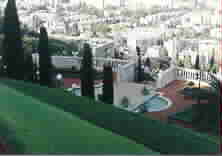 After
our meal, we returned to the Pilgrim House and then set off to walk down
the seven completed terraces below the Shrine of the Báb. These
terraces are beautiful in their cleanness and their simplicity, and, of
course, are also holy ground. After
our meal, we returned to the Pilgrim House and then set off to walk down
the seven completed terraces below the Shrine of the Báb. These
terraces are beautiful in their cleanness and their simplicity, and, of
course, are also holy ground.  We are able walk down and back up those steps which, some time in the future, will carry the kings and rulers of the world – and, my, they are some climb, those kings will need to be fit! From the steps we can see the start of the work on realigning Ben Gurion Street at the bottom of the mountain, a small effort compared with the work on the terraces. We are able walk down and back up those steps which, some time in the future, will carry the kings and rulers of the world – and, my, they are some climb, those kings will need to be fit! From the steps we can see the start of the work on realigning Ben Gurion Street at the bottom of the mountain, a small effort compared with the work on the terraces.
 (I was told later that such is the way of the members of the House of Justice that the first people to walk down the terraces when they first opened were pilgrims, and that as they were leaving, they met the members of the House on their way down for their first look – where else would you find such humility in men who hold so much power?)
(I was told later that such is the way of the members of the House of Justice that the first people to walk down the terraces when they first opened were pilgrims, and that as they were leaving, they met the members of the House on their way down for their first look – where else would you find such humility in men who hold so much power?)
When we arrived back in the Pilgrim House we found the members of the International Teaching Centre waiting to talk with us. And then, almost as soon as they had gone Mr Furútan and Dr Varqá (the two other remaining Hands of the Cause of God) arrive and regale us with stories about Pilgrimage past and the Four Year Plan. Both speak with a strength which belies their age (Mr Furútan is 91). It is a privilege to be able to meet with these spiritual giants who are yet so humble. |
| Day 4 |
Visit to the International Archives Building
|
|
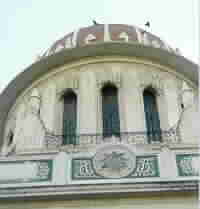 I have just had 30 minutes absolutely alone in the Shrine of the Báb – what a bounty to be able to pray unrestrainedly in the presence of the Most Exalted, the Return of Christ Himself. I know it is the wrong Tablet but it was very much "with tears".
I have just had 30 minutes absolutely alone in the Shrine of the Báb – what a bounty to be able to pray unrestrainedly in the presence of the Most Exalted, the Return of Christ Himself. I know it is the wrong Tablet but it was very much "with tears".
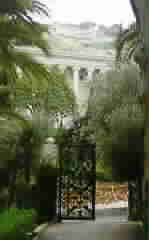 At four o'clock we were taken to the Archives building. Now I am not really interested in "museums" so had expected not to get as much from this visit as much as I should. And, in a way, my fears were realised, though that is my problem. Passing through the grand front entrance one enters the darkened, air conditioned interior of the building – and then the lights are turned on to show a most wonderful chamber, lined on the two longer sides with galleries. At the far end, there are three cabinets with their doors closed (all the cabinets are closed to protect their contents from light). It is to these that we are first led.
At four o'clock we were taken to the Archives building. Now I am not really interested in "museums" so had expected not to get as much from this visit as much as I should. And, in a way, my fears were realised, though that is my problem. Passing through the grand front entrance one enters the darkened, air conditioned interior of the building – and then the lights are turned on to show a most wonderful chamber, lined on the two longer sides with galleries. At the far end, there are three cabinets with their doors closed (all the cabinets are closed to protect their contents from light). It is to these that we are first led.
 They contain, from left to right, a photograph of Bahá'u'lláh, a triptych of paintings of Bahá'u'lláh (painted by a Christian artist) and a portrait of the Báb. For 30 minutes we are allowed to gaze on these portraits before the doors are, once again, closed to protect them.
They contain, from left to right, a photograph of Bahá'u'lláh, a triptych of paintings of Bahá'u'lláh (painted by a Christian artist) and a portrait of the Báb. For 30 minutes we are allowed to gaze on these portraits before the doors are, once again, closed to protect them.
What was my reaction? I really cannot say. In a way, it was a disappointment. The photograph, if one did not know better, could have been of any ordinary person. Granted it was taken only two weeks after an attempt on the life of the Blessed Beauty using poison. But it is, after all, just a photograph and cannot convey the full majesty of its subject. To my mind, the triptych said more of the artist than of the Subject. The main portrait had the Blessed Beauty in a typical "Christ pose" with one hand raised, pointing heavenwards, and the other indicating the earth. The (painted) portrait of the Báb was, on the other hand, exquisite. He is very slim, looks older than I imagined but very handsome with his green turban and bearded face.
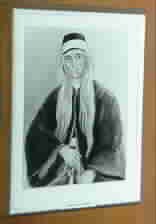 What was it that impressed me most? It is difficult to say really, there was so much it was impossible to take it all in. But what I do recall quite vividly was the blood-stained fragment of the shirt that the Báb was wearing at the time of His martyrdom. Also, a rendering in Arabic script of the final lines of the Tablet of Visitation, the letters of which were made up from a minute script which was the whole of the Kitáb-i-Aqdas. Yes, it is a museum and, at times, I did feel I was just another visitor on yet another guided tour, looking at an array of precious artefacts from the past, but then something amazing would appear, such as the sword of Mullá Husayn, and it all seemed so real again. The other abiding memory will be, of course, the original Tablets of the Báb and Bahá'u'lláh and 'Abdu'l-Bahá, many of them exquisitely illuminated, at the request of the Greatest Holy Leaf, and the superb calligraphy of Mishkín-Qalam.
What was it that impressed me most? It is difficult to say really, there was so much it was impossible to take it all in. But what I do recall quite vividly was the blood-stained fragment of the shirt that the Báb was wearing at the time of His martyrdom. Also, a rendering in Arabic script of the final lines of the Tablet of Visitation, the letters of which were made up from a minute script which was the whole of the Kitáb-i-Aqdas. Yes, it is a museum and, at times, I did feel I was just another visitor on yet another guided tour, looking at an array of precious artefacts from the past, but then something amazing would appear, such as the sword of Mullá Husayn, and it all seemed so real again. The other abiding memory will be, of course, the original Tablets of the Báb and Bahá'u'lláh and 'Abdu'l-Bahá, many of them exquisitely illuminated, at the request of the Greatest Holy Leaf, and the superb calligraphy of Mishkín-Qalam.
|
| Day 5 |
Visit to 'Akká, the prison, the House of
'Abbúd and Mazra'ih |
|
 Today is going to be really full – all day in 'Akká and ending up at Mazra'ih.
Today is going to be really full – all day in 'Akká and ending up at Mazra'ih.
So at 08:15 it was, once again, into the bus and off. To my delight the route took us through the old German Templar colony, where there is a house with the inscription "Der Herr ist nahe" (The Lord is nigh) over the door.
 Then we turned into Ben Gurion Street and – what a sight, such beauty as one looks back up the mountain towards the Shrine of the Báb and the newly planted terraces. It was our good fortune to be in the back of the bus and to be able to see this fantastic view.
Then we turned into Ben Gurion Street and – what a sight, such beauty as one looks back up the mountain towards the Shrine of the Báb and the newly planted terraces. It was our good fortune to be in the back of the bus and to be able to see this fantastic view.
The bus continued through the old city with is contrasting noise and dirt, past old building soon to pass into oblivion – under the relentless drive of "development" – to be replaced by more apartments.
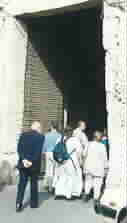 After about 30 minutes we arrive at our destination, a tiny back street leading into the old walled city of 'Akká. By us is a steel covered wooden door – the Land Gate to the old penal city. Through the gate, one turns sharp left (a technique to slow down any invader who might manage to breach the gate) and then enters what at one time would have been the main street, a street like any other in an old Arab town (I expect). As today is the Muslim Sabbath so is quieter than usual (though far from quiet, none-the-less). A little way up the street, on the left, is the house used by the Azalís, from which they watched for visiting Bahá'í pilgrims whom they reported to the authorities so that they could be ejected from the city.
After about 30 minutes we arrive at our destination, a tiny back street leading into the old walled city of 'Akká. By us is a steel covered wooden door – the Land Gate to the old penal city. Through the gate, one turns sharp left (a technique to slow down any invader who might manage to breach the gate) and then enters what at one time would have been the main street, a street like any other in an old Arab town (I expect). As today is the Muslim Sabbath so is quieter than usual (though far from quiet, none-the-less). A little way up the street, on the left, is the house used by the Azalís, from which they watched for visiting Bahá'í pilgrims whom they reported to the authorities so that they could be ejected from the city.
 By the side of the house is a small entrance which leads into the prison in which 'Abdu'l-Bahá was held for a night after some of the Bahá'ís (strictly against the orders of Bahá'u'lláh) murdered the Azalís. Later the murderers themselves were held here for several years. In front of us as we walk up the street is a mosque with a blue roof. It was here that 'Abdu'l-Bahá had a room in which he taught local people to read and write.
By the side of the house is a small entrance which leads into the prison in which 'Abdu'l-Bahá was held for a night after some of the Bahá'ís (strictly against the orders of Bahá'u'lláh) murdered the Azalís. Later the murderers themselves were held here for several years. In front of us as we walk up the street is a mosque with a blue roof. It was here that 'Abdu'l-Bahá had a room in which he taught local people to read and write.
 Turning to the left we pass through a market square and then there is the sea – but no longer with a high sea wall. It has been removed to give access to a marina. In the distance is the Sea Gate, but we will not pass through it at this time as it is still not Bahá'í property and is covered with garish "Coca-Cola" signs. We are told that St. Francis of Assisi once passed through the sea gate and stopped to prostrate him self, announcing to those present that one day the Glory of God would pass over that threshold. As we walk on, we enter the courtyard of the caravanserai where the Holy Family stayed for a short while after they were forced to leave the Most Great Prison (when it was required for barracks). My friend Brynhild tried buying a film here but they were adamant that is was 25 NIS and would not bargain.
Turning to the left we pass through a market square and then there is the sea – but no longer with a high sea wall. It has been removed to give access to a marina. In the distance is the Sea Gate, but we will not pass through it at this time as it is still not Bahá'í property and is covered with garish "Coca-Cola" signs. We are told that St. Francis of Assisi once passed through the sea gate and stopped to prostrate him self, announcing to those present that one day the Glory of God would pass over that threshold. As we walk on, we enter the courtyard of the caravanserai where the Holy Family stayed for a short while after they were forced to leave the Most Great Prison (when it was required for barracks). My friend Brynhild tried buying a film here but they were adamant that is was 25 NIS and would not bargain.
|
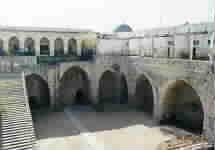
The Most Great Prison is currently being excavated (what Bahá'u'lláh would have seen is only a very small part, there is as much again below ground as above, and they are still digging), so we were not able to see the cell of the Blessed Beauty. It's a pretty grim looking place but it is difficult to judge what it was like at the time of Bahá'u'lláh.
|

 From
the Most Great Prison it is only a short distance to the House of 'Abbúd.
This is a comparatively small, attractive house, originally half of a pair
of houses (the other belonged to 'Údí Khammar). We were privileged
to enter the room originally inhabited by the Blessed Beauty and latter
by 'Abdu'l-Bahá. The room cannot much larger than 15ft by 12ft and
is the one in which the Kitáb-i-Aqdas was revealed. The other two
main rooms were shared by the 26 members of the family and believers. And
these rooms were even smaller than Bahá'u'lláh's. After the
murder of the Azalís, 'Údí Khammar built a dividing
wall to protect his family from the Bahá'ís but later, hearing
that 'Abdu'l-Bahá could not marry because He had no place to live,
he made available one of the rooms of his own house. In time, the Holy
Family was able to move into 'Údí Khammar's half of the house,
which was much roomier. Here Bahá'u'lláh had a room with
a small balcony, from which He would address the believers gathered below. From
the Most Great Prison it is only a short distance to the House of 'Abbúd.
This is a comparatively small, attractive house, originally half of a pair
of houses (the other belonged to 'Údí Khammar). We were privileged
to enter the room originally inhabited by the Blessed Beauty and latter
by 'Abdu'l-Bahá. The room cannot much larger than 15ft by 12ft and
is the one in which the Kitáb-i-Aqdas was revealed. The other two
main rooms were shared by the 26 members of the family and believers. And
these rooms were even smaller than Bahá'u'lláh's. After the
murder of the Azalís, 'Údí Khammar built a dividing
wall to protect his family from the Bahá'ís but later, hearing
that 'Abdu'l-Bahá could not marry because He had no place to live,
he made available one of the rooms of his own house. In time, the Holy
Family was able to move into 'Údí Khammar's half of the house,
which was much roomier. Here Bahá'u'lláh had a room with
a small balcony, from which He would address the believers gathered below.
 |
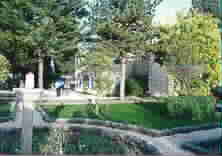 So,
having completed our first visit to 'Akká, we are carried to Mazra'ih,
just a few miles south of Nahariyya and from which one can see the hills
of Lebanon. This is the first of the mansions that the Bahá'u'lláh
was able to move to after His imprisonment in the city was over and He
was here for about two years. It is the house with the much photographed
flight of stairs. So,
having completed our first visit to 'Akká, we are carried to Mazra'ih,
just a few miles south of Nahariyya and from which one can see the hills
of Lebanon. This is the first of the mansions that the Bahá'u'lláh
was able to move to after His imprisonment in the city was over and He
was here for about two years. It is the house with the much photographed
flight of stairs.
 At the top of the stairs was a small ante-room with several rooms off it,
the largest of which was occupied by the Blessed Beauty. And there in the
corner is His bed – not a later one, but the very bed in which the Desire
of my heart slept and woke. (I guess I should mention that nearly all the
rooms we were seeing were laid our by the beloved Guardian, the reason
being that many of the Bahá'í properties in the Holy Land
were occupied by the Covenant Breakers, some right up to the mid-1950s.
Much of the furniture and the pictures came later and were gifts from the
believers to the World Centre.)
At the top of the stairs was a small ante-room with several rooms off it,
the largest of which was occupied by the Blessed Beauty. And there in the
corner is His bed – not a later one, but the very bed in which the Desire
of my heart slept and woke. (I guess I should mention that nearly all the
rooms we were seeing were laid our by the beloved Guardian, the reason
being that many of the Bahá'í properties in the Holy Land
were occupied by the Covenant Breakers, some right up to the mid-1950s.
Much of the furniture and the pictures came later and were gifts from the
believers to the World Centre.)
 To
my great delight, in the dining room there is the original calligraphy
of Mishkín-Qalam of the picture which we have on the living room
wall. It is all decorated in gold and red. What a bounty to be able to
see this amazing work of art, created by a master craftsman – probably the
best of his time. To
my great delight, in the dining room there is the original calligraphy
of Mishkín-Qalam of the picture which we have on the living room
wall. It is all decorated in gold and red. What a bounty to be able to
see this amazing work of art, created by a master craftsman – probably the
best of his time.
The gardens around the mansion at Mazra'ih were still being planted
but there were already many beautiful flowers and trees. Two Israeli girls
watched us through the gate as we wander around the garden. I wonder what
they are thinking – they make no effort to leave until we ourselves have
to leave and, ensconced in our air conditioned bus, return to the bustle
of Haifa. |
Today I have had a glimpse of what all this is about.
There was no formal programme for the day so four of us were the guests of one of the staff of the World Centre for the day. After walking down 686 steps (or was it 586?—it's difficult to keep count.) I arrived at the Pilgrim House full of anticipation. At 10.30 we set off for 'Akká.
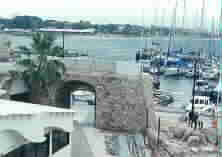 There has been a lot of work done in the city to try to make it more attractive to visitors but much of the old town must be similar to how it was when Bahá'u'lláh was here.
There has been a lot of work done in the city to try to make it more attractive to visitors but much of the old town must be similar to how it was when Bahá'u'lláh was here.  Because we are not on a guided tour, we are free to wander around and are able to view the back of the Sea Gate (which does not have any "Coca- Cola" signs!). We wandered through the town and past fascinating shops selling spices, and selling everyday items like shoes etc. The streets are narrow and crowded, a contrast from the previous day. We stop to eat in a local cafe (20NIS + 4 for a drink). It is clean and the food is well prepared. Satisfied, we wandered back through the streets to the car and drove on to Bahjí.
Because we are not on a guided tour, we are free to wander around and are able to view the back of the Sea Gate (which does not have any "Coca- Cola" signs!). We wandered through the town and past fascinating shops selling spices, and selling everyday items like shoes etc. The streets are narrow and crowded, a contrast from the previous day. We stop to eat in a local cafe (20NIS + 4 for a drink). It is clean and the food is well prepared. Satisfied, we wandered back through the streets to the car and drove on to Bahjí.
I cannot describe the feeling of being able to pray at the Shrine. For 1½ to 2 hours I sat amongst the other pilgrims in solid personal prayer, and reading the prayers of Bahá'u'lláh. My one regret is that it is not possible to circumambulate the Shrine, at least not in the way one can with the Shrine of the Báb. I can only hope that my prayers will be answered. But it is mentally exhausting and by the time I came out, I was ready to collapse into a comfortable chair in the Pilgrim House. We drove back to Haifa, the pretty way, in threatening rain (though it did hold off).
In the morning, before going to 'Akká, I had briefly visited the Shrine of the Báb but, as it was open to visitors, was only able to read the Tablet of Visitation. This evening I decided to go back and this time was able to circumambulate the Shrine and pray at the threshold, but not for long. I am tired and find it difficult to concentrate. And then, once again, I circumambulate the Shrines and pray at the Shrine of 'Abdu'l-Bahá. Once more I pray to the Lord that my prayers will be answered, but I am so tired that I cannot stay for long and return to the Pilgrim House.
|
Day 7 |
Visit to the Monument Gardens and the
Temple Land |
|
 Another day! In every way it gets better and better, though I have to admit that in my exhaustion I feel that I am more of a tourist than a pilgrim.
Another day! In every way it gets better and better, though I have to admit that in my exhaustion I feel that I am more of a tourist than a pilgrim.
This morning we visited the site of the future Bahá'í Temple on the top of the mountain, 300m above the city of Haifa, back there down in the bay. There was read the Tablet of Carmel (which is the manifesto for the work being undertaken on Mount Carmel), but it is noisy and it is difficult to appreciate the peaceful atmosphere here. The obelisk at the site, and a duplicate one, will be incorporated into the overall design.
|
 And then it is back to the bus and we are driven down Hatzionut, through the newly lowered road to enter the Monument Gardens. [Aside: I am told that before the Bahá'ís started work on lowering the road by some 6m, there were about six accidents a day by the corner of Shifra Street. Since the work started, there had been none.]
And then it is back to the bus and we are driven down Hatzionut, through the newly lowered road to enter the Monument Gardens. [Aside: I am told that before the Bahá'ís started work on lowering the road by some 6m, there were about six accidents a day by the corner of Shifra Street. Since the work started, there had been none.]
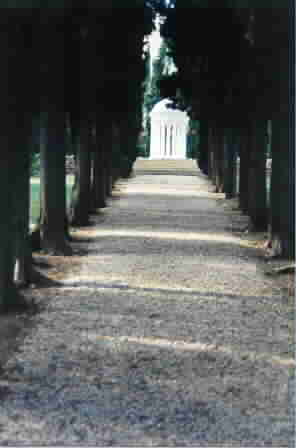 It is difficult to capture the atmosphere of the gardens due to the noise of traffic and the building work around us. But we try our best. Visiting first the Shrine of Munhírih Khánum and then Mírzá Mihdí and the Greatest Holy leaf. Unless one calls out the prayer and the readings, they cannot be heard above the noise. Once again, all too soon, we return to the Pilgrim House. There being no formal activity for the rest of the day, Brynhild (with whom I have shared this Pilgrimage and who is like a sister to me) and I walk down to the Templar colony, by way of the House of ‘Abdu'l-Bahá, and then down Ben Gurion Street. The view up the mountain is just amazing. Even though only a few of the terraces are complete, the image is there and one can almost see the final effect. We seek out the Templar house with the words "Der Herr ist nahe. 1876" inscribed over the front door. If only they had known how "nahe" He was!
It is difficult to capture the atmosphere of the gardens due to the noise of traffic and the building work around us. But we try our best. Visiting first the Shrine of Munhírih Khánum and then Mírzá Mihdí and the Greatest Holy leaf. Unless one calls out the prayer and the readings, they cannot be heard above the noise. Once again, all too soon, we return to the Pilgrim House. There being no formal activity for the rest of the day, Brynhild (with whom I have shared this Pilgrimage and who is like a sister to me) and I walk down to the Templar colony, by way of the House of ‘Abdu'l-Bahá, and then down Ben Gurion Street. The view up the mountain is just amazing. Even though only a few of the terraces are complete, the image is there and one can almost see the final effect. We seek out the Templar house with the words "Der Herr ist nahe. 1876" inscribed over the front door. If only they had known how "nahe" He was!
And then having visited the ATM and booked sheruts for our return to Tel Aviv, we take the cable car up the mountain to the top of Carmel. We have a shwarmi and cheesecake and cappuccino and fall in love with the two sweet little cats who keep the floor of the falafel shop clean. We visit Avraham Ohana, small shop for "souvenirs". Brynhild and Avraham had a great time together as he knew the kibbutz where she had worked years ago. Then, after picking up some of my photographs, we head back down 700+ steps, back to Puah Street and then on to the Pilgrim House. Although I am thoroughly dehydrated, I am drawn into the central room to listen to Mr Furútan talking informally to the Pilgrims. This man is so gentle and he comes to the Pilgrim House every night, just to talk and reminisce. He is an inspiration to us all, and an example. |
| Day 8 |
Visit to the Bahjí Mansion,
the House of 'Abdu'lláh Pashá and the Ridván
Garden |
|
Today, I finally broke down and just wept.
Our programme for the day had started, as usual, at 8.30 as we set out for Bahjí, to see round the mansion where Bahá'u'lláh spend the last years of His life. The journey passed quickly this time and it was not long before were, once again, entering the West Gate into the grounds at Bahjí. Once more we decanted ourselves from the bus and, once more, we are permitted to enter the small building that contains the most blessed spot in the entire earth. But only for a few minutes – time just to say a few prayers, for forgiveness, for healing and for spiritual qualities before prostrating oneself before the threshold of the room in which are buried the mortal remains of Him Who God made Manifest.
And then, through the light rain we pass into the mansion of 'Údí Khammár, the mansion of Bahjí. Here is the place where the Blessed Beauty spent the last 13 years of His life on this earth. As with the other buildings, we remove our, by now wet, shoes and leave them in the small kitchen in the corner of the building and pass quietly into the small corner room once occupied by Bahá'u'lláh. The quiet peace is shattered several times by the sound of military aircraft overhead, but it does not matter: nothing disturbs the spiritual stillness of this place. It is in this room that Edward Granville-Browne met Bahá'u'lláh, as described in his book.
Then, we pass through the other rooms which had been occupied by the various members of the Holy Family. There are many items to see (and very little time to see them) but I do not recall them – my mind is just totally overwhelmed. In one room are the original coffin of Navváb and the two gravestones of Navváb and Mírzá Mihdí. In other rooms are various possessions of the beloved Guardian. And everywhere are the most wonderful examples of the calligrapher's art. After a short time on the balcony surrounding the upper story, there is time only for a final visit to the Pilgrim house and for an unhurried walk back to the bus.
It was on the journey to the House of 'Abdu'lláh Páshá that I came to the sudden realisation that I had just had my last visit to the Shrine at Bahjí and that I may never be there again. As we entered the house, and surrounded by the chatter of the other pilgrims, I can no longer hide my anguish and just weep quietly. It is not possible to describe what emotion I felt (and still feel at I type this) Even the memory brings tears to my eyes. At lunch, I sat next to a little Persian/Malay girl and I wonder what she makes of this outburst of emotion. She is so serene and smiling as we talk and eat.
With lunch over, we are ready to climb the stairs to that part of this mansion (with over 100 rooms) where 'Abdu'l-Bahá lived with His family and many of the Bahá'ís and early pilgrims. Once again, it is all a blur. Once again, we pass through rooms full of the archives of our Faith. Personal belongings, pictures of the family, brushes, etc. It comes to mind that it is as if the Christians still had the cross on which Christ was crucified, or the crib in which He was born. Or the bottle which Mary had used to carry the oil with which she anointed His blessed feet, or the dice which the roman soldiers had used to gamble for Jesus' clothes. These objects are the material reminder to the pilgrims of the sufferings of the Holy Family and the happiness of later days. They are so real – 'Abdu'l-Bahá's scissors, a portrait of Shoghi Effendi as a small child, the room of the Greatest Holy Leaf (in which the remains of the Báb were lodged until the Master could build the embryonic shrine on the north face of Mount Carmel. It does not matter that this is not the original furniture: it was all set up by Shoghi Effendi so well that it exudes the atmosphere of the house at the time of its occupation.
Opposite the living apartments of the family is the reception hall for visiting dignitaries, and Shoghi Effendi's small room, used when he was a child (with a copy of the letter 'Abdu'l-Bahá wrote to him in answer to his entities to have a tablet for himself). There is the schoolroom where the children of the household were taught and the birani where the Master would first receive His guests. In the birani we pray together (in Ethiopian, Italian and English) and then we are back to earth and back on the bus. As we leave the courtyard, small Arab children throw stones at the bus and I wonder if it is just naughtiness, or dislike of westerners or that we are Bahá'ís. It is, sadly, a poor quarter around this beautiful house.
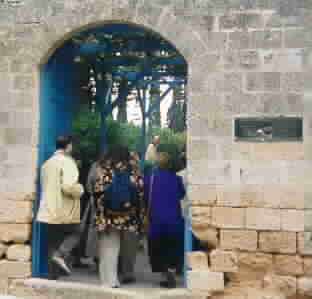 Once again we pass through the urban sprawl of 'Akká to our final visit of the day – to the Ridván Garden, the garden where Bahá'u'lláh used to go to retreat.
Once again we pass through the urban sprawl of 'Akká to our final visit of the day – to the Ridván Garden, the garden where Bahá'u'lláh used to go to retreat.
 There is a little house at one end of the garden which we enter. There in this quiet spot we seem to be, once again, in the presence of the Blessed Beauty. The room is exactly as it was when He visited there. There is the chair on which He sat and the bed on which He rested. This time it is for real for this small house has never been out of the hands of the followers of the Blessed Beauty. On the chair and the bed are the most fragrant of roses, permeating the whole room with their divine perfume.
There is a little house at one end of the garden which we enter. There in this quiet spot we seem to be, once again, in the presence of the Blessed Beauty. The room is exactly as it was when He visited there. There is the chair on which He sat and the bed on which He rested. This time it is for real for this small house has never been out of the hands of the followers of the Blessed Beauty. On the chair and the bed are the most fragrant of roses, permeating the whole room with their divine perfume.
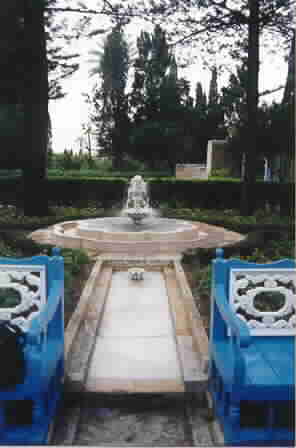 And then there are oranges – hundred's of oranges, given freely to the pilgrims, to eat there and then, or to take away. They are piled up on bowls on the seats by the fountain in the centre of the Garden and we sit and talk to each other and take the obligatory photographs.
And then there are oranges – hundred's of oranges, given freely to the pilgrims, to eat there and then, or to take away. They are piled up on bowls on the seats by the fountain in the centre of the Garden and we sit and talk to each other and take the obligatory photographs.
At last we return to our bus and are carried back to Haifa, to falafels, and to shwarmi.... and cakes – freshly baked. Then it is slowly up that hill to the Pilgrim House, to friends, to prayers, to bed.
|
| Day 9 |
Final visit to the House of the Master and to
the Seat of the Universal House of Justice followed by
Pilgrim Farewells and final prayers at the Shrines of the Báb and
'Abdu'l-Bahá |
|
Well, it is nearly ended. And we are already making our farewells.
The morning started much the same as the others, with 686 steps and another 150 or so down the Shifra steps, later.
But first I have a private duty and must say prayers for a very dear friend who is not at all well. And for his wife too. And then I have to run down the Shifra Steps to the house of the beloved Master, there to perform that well establish Bahá'í ritual, the taking of the group photographs.
The Master's house became, in turn, the home of Shoghi Effendi and Amatu'l-Bahá Rúhíyyih Khánum, and there she still lives so we are really her guests. We visit only four of the rooms. The first is the room where the Master met with his visitors, from kings to paupers. Then in the opposite side of the house is the one where the Master lived and passed away from this earthly existence. Next door was the room in which that wonderful exemplar, Bahíyyih Khánum (the Greatest Holy Leaf), lived and passed away. Both these rooms have been kept as they were when the Master and the Greatest Holy Leaf lived in them, gentle in their simplicity and totally unostentatious. One by one we withdrew and passed into a sitting room where we waited for those who wished to linger longer. As I sit, below the portrait of the beloved Master, I gaze into the eyes of the Greatest Holy Leaf, whose portrait is hung opposite me, and reflect on the spiritual beauty and strength of that small figure, a haven of peace amongst the storms that broke around her.
As we were leaving my friend and I were delighted to be asked to come to lunch in the apartment of two Bahá'ís who work here at the World Centre. Their apartment was small but beautiful, just off Ben Gurion Street and with a clear view of the unfolding development on the side of Mount Carmel.
And then it is stairs and more stairs back to the Pilgrim House. At 1430 we gather for our last visit of our Pilgrimage – to be shown round the Seat of the Universal House of Justice. There is so much that one could write about this elegant building, the heart of the Administration of our Faith. It is a palace – but not the palace of kings, proud in their wealth and power and possessions. This palace has simplicity in its grandeur. It is the nerve centre of the Faith and yet it has that quiet dignity that one has come to expect. 5½ storeys high it faces Bahjí across the bay of Haifa and, together with the Shrine of the Báb, dominates the view from lower Haifa.
Amongst the things we see are several models of the terraces of the Shrine of the Báb and the arc of the World Centre buildings as they will be when they are complete, it will be an incredible site once it is complete. We keep climbing and climbing, passing through beautiful rooms and offices to emerge ("please mind your head") eventually onto the roof of the building, from whence we are free to contemplate the beauty of the gardens and the wonderful views over the city of Haifa and the bay beyond.
 And there, on both sides, are the construction sites – the Terraces and the Centre for the Study of the Texts to the south and the new seat of the International Teaching Centre to our right. Once more, I become a tourist, and snap away happily! Then, all too soon, it is over and we start our descent back to ground level. But there is one more item on our programme, not mentioned in our – we enter the auditorium of the lecture theatre for a final talk, not by a member of the House, nor the ITC, but from the architect of the Indian Temple and site manager for all the construction work on Mount Carmel. And there, on both sides, are the construction sites – the Terraces and the Centre for the Study of the Texts to the south and the new seat of the International Teaching Centre to our right. Once more, I become a tourist, and snap away happily! Then, all too soon, it is over and we start our descent back to ground level. But there is one more item on our programme, not mentioned in our – we enter the auditorium of the lecture theatre for a final talk, not by a member of the House, nor the ITC, but from the architect of the Indian Temple and site manager for all the construction work on Mount Carmel.
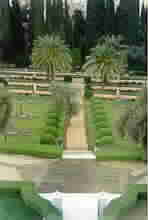 He tells us stories of the construction work – its ups and downs, the problems and their solutions. It is an inspiring address, illustrated with slides of the construction work, architects drawings, and, finally, photographs of the Indian Temple. He tells us stories of the construction work – its ups and downs, the problems and their solutions. It is an inspiring address, illustrated with slides of the construction work, architects drawings, and, finally, photographs of the Indian Temple.
After returning to the Pilgrim House we make our final visit to the Shrines, a perfect ending to a wonderful Pilgrimage. And then we are served tea, or coffee, and biscuits by members the World Centre staff and we start to make our farewells to those who are leaving that night. Then I make my way up to my hotel with some of the friends. And that is it. The Pilgrimage is over – well so I thought. |
| Day 10 |
Dawn Prayers (optional)
Pilgrims must leave the Haifa/'Akká area by sunset. |
|
Thanks to the very kind invitation a charming Indian lady working at the World Centre, Brynhild, Roderick and I were enabled to travel back, once again to Bahjí – an undeserved but very much appreciated bounty which allowed me to come to peace with myself and to leave with my spiritual desires satisfied.
Back in Haifa, together, we ate falafel and shwarmi (my last) and walked back up those interminable steps to the Pilgrim House. During the afternoon, I was able, once again to pray at the Shrines of the Báb and 'Abdu'l-Bahá before, my hunger satisfied, I walked back down to Puah Street to get the sherut to Tel Aviv.
As the others left for their night flights, two of us sat at the airport tired but happy through the night until, at last even my friend had to go, probably never to be seen again. But there will always be a bond between us – one cannot share a Pilgrimage without developing a deep relationship with each other.
During the morning various pilgrims passed my through temporary home until, at last, I was alone, tired and solitary, waiting for my evening flight to bring me back to England and the cold weather. On the flight I was asked several questions about the Faith, but was too tired to give more than brief answers to what was requested. Then, it was through passport control and customs to be greeted, at last, by some friends with whom I was to stay the night before, finally returning home to Skye.
As I wrote shortly afterwards, I have, during my life, had some wonderfully spiritual experiences, but I felt then and still feel now that this was the summit – that never shall I experience, in this life, anything to match it. No-one is ever the same after a Pilgrimage, be it Jewish, Christian, Muslim, Bahá'í, or any other Faith, but sometimes the full understanding of the experience does not come until much later. And there I shall end. I hope that my thoughts, which as before, I must emphasize are purely mine and in no way an "official" view, will inspire others either to go on Pilgrimage themselves or to investigate what has brought me so much happiness.
Thank-you Bahá'u'lláh for what You have done.
|
|
|
